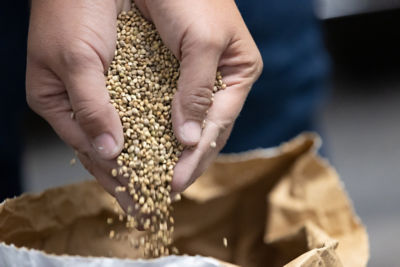» Proper head formation in cauliflower is very sensitive to environmental conditions.
» Warm temperatures and dry conditions can result in problems with head size and curd quality.
» Synchronizing varieties, planting dates, and anticipated weather conditions can help minimize problems with head development and curd quality.
Compared to broccoli and cabbage, cauliflower is very sensitive to environmental conditions. In particular, proper head formation and curd quality require a fairly narrow range of temperature and moisture conditions. It is not unusual for heads to fail to form properly and for problems with curd quality to occur.1,2,3 Cool temperatures and a moist atmosphere are most favorable for cauliflower production. Curd (head) development is triggered by a combination of plant age and air temperature factors. The optimal range of temperature for the initiation of heads in main season cauliflower varieties grown in North America is 50° to 60°F. However, there are tropical and winter varieties that form heads at higher and lower temperatures respectively. Cultivars and planting dates must be coordinated so that heading occurs when temperatures are in the correct range.1 Head quality can also be affected by exposure to sunlight. Curds may turn yellow if exposed to the sun, and the developing heads must be covered to prevent discoloration.1
 Figure 1. The condition of riciness of a head of cauliflower. International Produce Training, http://www.ipt.us.com.
Figure 1. The condition of riciness of a head of cauliflower. International Produce Training, http://www.ipt.us.com.
Both riciness (riceyness) and fuzziness of cauliflower heads can occur when temperatures are warm (above 80°F) during head formation.1,2 High humidity and nitrogen levels can also contribute to the development of these conditions.4 Riciness is a condition where the floral parts elongate and grow up through the heads and small, white or purple flower buds form.6,7 The buds separate giving the curd an open and uneven appearance (Figure 1). Fuzziness is similar, with the heads developing a fuzzy/velvety appearance because the flower pedicels elongate (Figure 2). Fuzziness is caused by large day/night temperature fluctuations (high day temperatures and low night temperatures). Some varieties are more susceptible than others to these problems. Planting varieties at the correct time to avoid warm weather during head formation is the best way to manage both of these conditions.6,7
 Figure 2. Fuzziness of cauliflower is caused by elongated pedicels. International Produce Training, http://www.ipt.us.com.
Figure 2. Fuzziness of cauliflower is caused by elongated pedicels. International Produce Training, http://www.ipt.us.com.
Buttoning is the term used to describe the condition of a plant forming small curds that never reach a marketable size. Buttoning is usually the result of curds developing on small plants where there is not enough leaf area to support curd growth. Conditions that can lead to buttoning include cold temperatures at planting, temperatures over 80°F at the time of planting, low soil fertility (nitrogen), micronutrient deficiencies, low soil moisture, and damage from disease or insects.3,4 One of the most common causes of buttoning is using seedlings that are too old at the time of transplanting. Buttoning is also more likely to occur with early season varieties.
Some references refer to buttoning as premature curd formation, indicating that curd initiation starts before the plant can support curd development. These articles speculate that seedlings which have initiated curd formation (seedlings that are “past their juvenile state”) before transplanting are more likely to develop problems with buttoning. However, a study published in 1984 found that the frequency of buttoning was associated with restrictions of leaf growth, but not with the amount of curd initiation at the time of transplanting.5
Plants that were older and larger at the time of transplanting tended to have reduced leaf growth after transplanting, and this reduced leaf growth was the main cause of buttoning. In this study, seedlings that had more than 14 leaves and had dry weights greater than 1.1g at transplanting were “prone to severe buttoning.” This research suggests that any conditions that retard leaf growth after transplanting can result in a higher frequency of buttoning. If planting is delayed and seedlings are getting too large, storing the seedlings at low temperatures may help retard seedling growth until they can be transplanted, reducing the likelihood of buttoning. These researchers also explain that later season varieties tend to produce more leaves before curd initiation and can sutain more leaf area reduction without suffering from buttoning as compared to earlier varieties that produce fewer leaves.
Blind bud is a condition where no central growing point forms and no head develops on a cauliflower plant. This condition is usually associated with periods of extremely warm weather, with day-time air temperatures over 86°F and night-time air temperatures over 77°F.1,4,5 Other factors that can cause a lack of head formation include mechanical injury, insect damage, and bird feeding. Some varieties tend to be more susceptible to this condition than other varieties.1
 Figure 3. Loose and leafy curds of cauliflower.
Figure 3. Loose and leafy curds of cauliflower.
When bracts (small green leaves) grow between the curd segments in a head of cauliflower, the heads are said to be suffering from leafy curds.2,4 This condition is usually associated with high temperatures and low soil moisture levels (drought) at the time of head formation.3,4
Stressful conditions, such as fluctuating temperatures and moisture levels, that slow plant growth can result in the formation of heads with loosely formed, less compact curds, a condition known as loose curds (Figure 3). Rapid vegetative growth resulting from excessive nitrogen levels can also result in the formation of loose curds. 2,4
The curd of some varieties will yellow if exposed to the sun, and these varieties require a period of blanching, where outer leaves are gathered and tied around the developing head for a period of time to prevent discoloration. Yellowing is more likely to occur when temperatures are above 80°F.1 The blanching procedure involves gathering the large leaves and bringing them together over the heads and binding the leaf tips together with a rubber band or twine. This is done when the heads are two to three inches in diameter.3,8 Blanching should be done for four to eight days during warm weather and for as long as 15 days when conditions are cooler. Some cauliflower varieties are self-shading, with leaves that grow up over the heads, and do not need to have leaves tied together.8 Other varieties, including the green and orange colored varieties, are not greatly affected by sun exposure.4 A browning of the curds can develop as a result of boron deficiency.4
Symptoms of hollow stem start as small cracks in the internal stem tissue. As the stems grow, the cracks expand and cavities form. These cavities may extend up into the head. Hollow stem is associated with conditions that encourage rapid plant growth including wide plant spacings and high nitrogen levels.4 Varieties vary in their susceptibility to hollow stem.7 Boron deficiency can also cause the formation of hollow stems with internal browning (Figure 4).2 Growing varieties at the appropriate plant spacings and providing balanced and appropriate fertilization will usually prevent the formation of hollow stems.6
 Figure 4. Hollow stem and internal discoloration caused by boron deficiency. John Howell, University of Massachusetts.
Figure 4. Hollow stem and internal discoloration caused by boron deficiency. John Howell, University of Massachusetts.
1 Koike, S., Cahn, M., Cantwell, M., Fennimore, S., Lestrange, M., Natwick, E., Smith, R., and Takele, E. 2009. Cauliflower production in California. UC Vegetable Research and Information Center. Publication 7219.
2 Sanders, D. 2001. Cauliflower. NC State Extension: Horticulture Information Leaflets.
3 Cabbage, broccoli, cauliflower, and other brassica crops. 2018. New England Vegetable Management Guide. https://nevegetable.org/crops/cabbage-broccoli-cauliflower-and-otherbrassica-crops.
4 Johnson, G. 2008. Disorders in cole crops. University of Delaware, Cooperative Extension. https://extension.udel.edu/weeklycropupdate/?p=464.
5 Wurr, D. and Fellows, J. 1984. Cauliflower buttoning-the role of transplant size. Journal of Horticultural Science 59:419-429.
6 University of California. 1987. Integrated pest management for cole crops and lettuce. UCANR Publication 3307.
7 Dickson, M. 2007. Riciness of cauliflower. In Compendium of Brassica Diseases, Rimmer, S., Shattuck, V., and Buchwaldt, L. editors. The American Phytopathological Society, St. Paul.
8 Trounfeld, J. 2010. Cauliflower. University of Maryland Extension. GE 107. Websites verified 10/25/2018
For additional agronomic information, please contact your local seed representative.
Performance may vary from location to location and from year to year, as local growing, soil and weather conditions may vary. Growers should evaluate data from multiple locations and years whenever possible and should consider the impacts of these conditions on the grower’s fields. The recommendations in this article are based upon information obtained from the cited sources and should be used as a quick reference for information about nematodes and vegetable crops. The content of this article should not be substituted for the professional opinion of a producer, grower, agronomist, pathologist and similar professional dealing with this specific crop.
SEMINIS VEGETABLE SEEDS, INC. DOES NOT WARRANT THE ACCURACY OF ANY INFORMATION OR TECHNICAL ADVICE PROVIDED HEREIN AND DISCLAIMS ALL LIABILITY FOR ANY CLAIM INVOLVING SUCH INFORMATION OR ADVICE. 180626100306110118DME
Seminis® is a registered trademark of Bayer Group. All other trademarks are property of their respective owners. ©2018 Bayer Group. All rights reserved.



